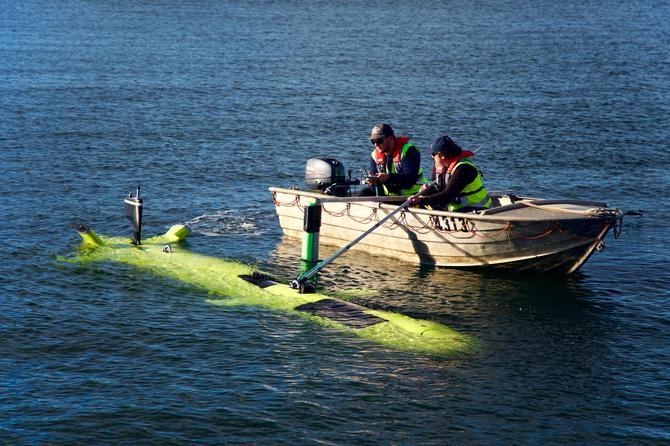An innovative new autonomous underwater vehicle (AUV) capable of diving up to 5,000 metres, operating underneath the ice and gathering data on Antarctic research missions was recently unveiled at the University of Tasmania’s Australian Maritime College (AMC). During an official ceremony, the $5 million polar vehicle was granted the name nupiri muka, which means 'Eye of the Sea' in palawa kani, the language of Tasmanian Aborigines. Here is the story behind this special name.
Address by Daisy Allan, palawa kani language Worker, Tasmanian Aboriginal Centre (now Corporation) at launch of Australian Maritime College AUV, 18 August 2017:
"nupiri muka means ‘Eye of the Sea’ in palawa kani, the language of Tasmanian Aborigines.
The
Tasmanian Aboriginal Centre were delighted to receive a request from the Australian
Maritime College to give the new Autonomous Underwater Vehicle a palawa kani name. In our role as the representative body for
Tasmanian Aboriginal language, the TAC responds to such requests on behalf of
the Aboriginal community - in line with the community’s Policy and Protocol for
Use of palawa kani.
nupiri muka - a combination of palawa kani words for ‘eye’ (nupiri) and ‘sea’ (muka) was chosen.
As a scientific research vessel, nupiri muka the AUV acts as ‘eyes’ in the depths of the oceans, enabling the survey of distant and unfamiliar locations and collecting data to further knowledge and understanding. In a similar way, early Europeans visiting lutruwita (now Tasmania) were keen to document the lifestyle and practices of the Aboriginal inhabitants; this included writing down the words they heard Aboriginal people speaking.
nupiri, the palawa kani word for ‘eye’ was first recorded in 1777 at Adventure Bay on Bruny Island, by William Anderson, a surgeon with Captain Cook’s expedition.
After this, several officers and scientists in both the d'Entrecasteaux Expedition in 1793 and the Baudin Expedition of 1802, also noted this word and confirmed its meaning. Both these expeditions had a major focus on research through information gathering. The characteristic qualities of those scientists – their meticulous observation and recording of detail – have proven invaluable to our people, as they have left us with the best records of some of the early Tasmanian Aboriginal languages, spoken by our ancestors on their own country before invasion. Even after the disruption brought by colonisation, this word nupiri was still spoken and was recorded until the late 1840s, when our people were imprisoned at Wybalenna on Flinders Island.
The word muka also originates from a coastal area, first recorded in Macquarie Harbour, and then across many language regions, including Cape Portland in the north east. The Aboriginal women who survived to become the matriarchs of the families of the Tasmanian Aboriginal community today all originated from the north-east.

Most of our revived language derives from the NE languages, as sadly, not enough of any one Tasmanian language remained to still be spoken right through. So palawa kani is a composite of remnants of the 8 to 12 original languages once spoken here. We retrieve it through historical research and linguistic analysis and community knowledge, and we write it in the sound and spelling system we developed to represent the original Aboriginal sounds. When language retrieval began in the early 1990s,there were no speakers of our language. Now we have at least two generations of Aborigines who have grown up learning and speaking their language. Since 2012 the State Government has acknowledged Aboriginal language, with the long overdue Aboriginal Dual Naming Policy, and 14 names now beginning to appear on signs and maps. palawa kani has been spoken in a children’s TV animated show, in a film under production, it has named meeting rooms, restaurants, art works and a newly discovered Velvet Worm – but this is its first trip underwater.
That’s very fitting, as the Aborigines of lutruwita have always been seafarers and builders of seafaring vessels; from ninga (canoes made of tea tree) and tuylini (canoes made of stringy bark) through to modern day lukrapina (boats) - most recently, the Truwana Lady, built by Kerry Mansell and others in 2006, and named for their island home, truwana/Cape Barren Island.
These were the things that were considered when choosing the name for this vessel.
nayri nina-tu (We thank you) for the opportunity to let palawa kani rule beneath the waves, and tapilti nayri (bon voyage) to nupiri muka."